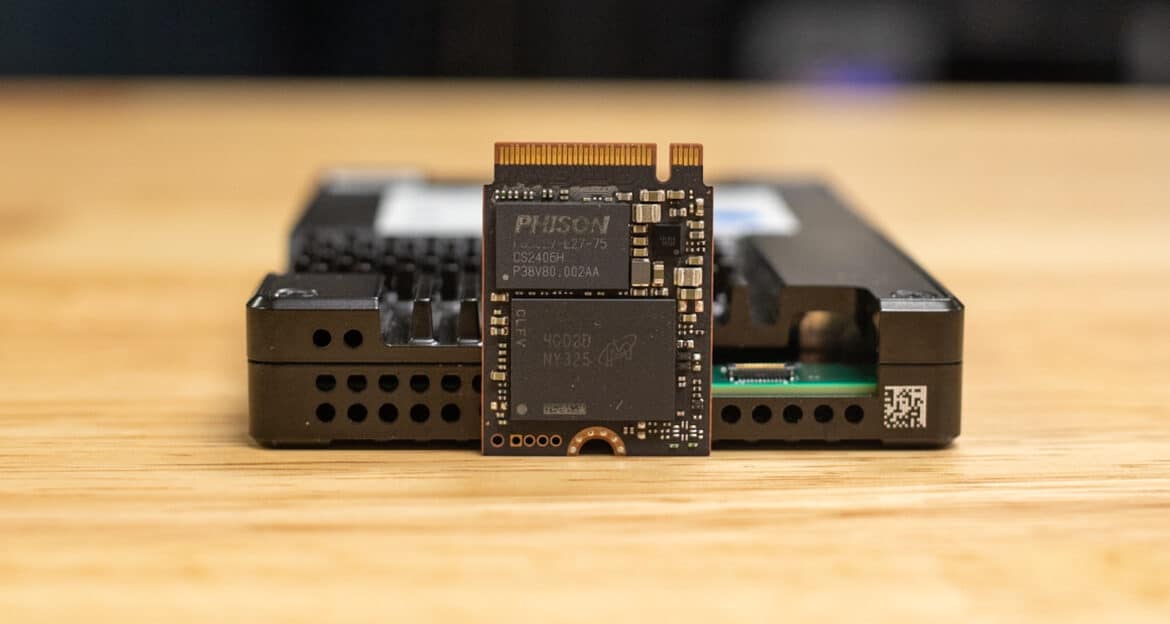The Crucial P310 combines speed and capacity in a small form factor, making it a great solution for a range of space-constrained devices.
The Crucial P310 is the company’s latest high-performance 2230 M.2 Gen4 SSD, leveraging Micron’s advanced 3D NAND technology. The primary use cases for 2230 M.2 drives include ultrabooks, compact laptops, tablets, and small-form-factor PCs. Its small size fits space-constrained devices while still providing high performance.
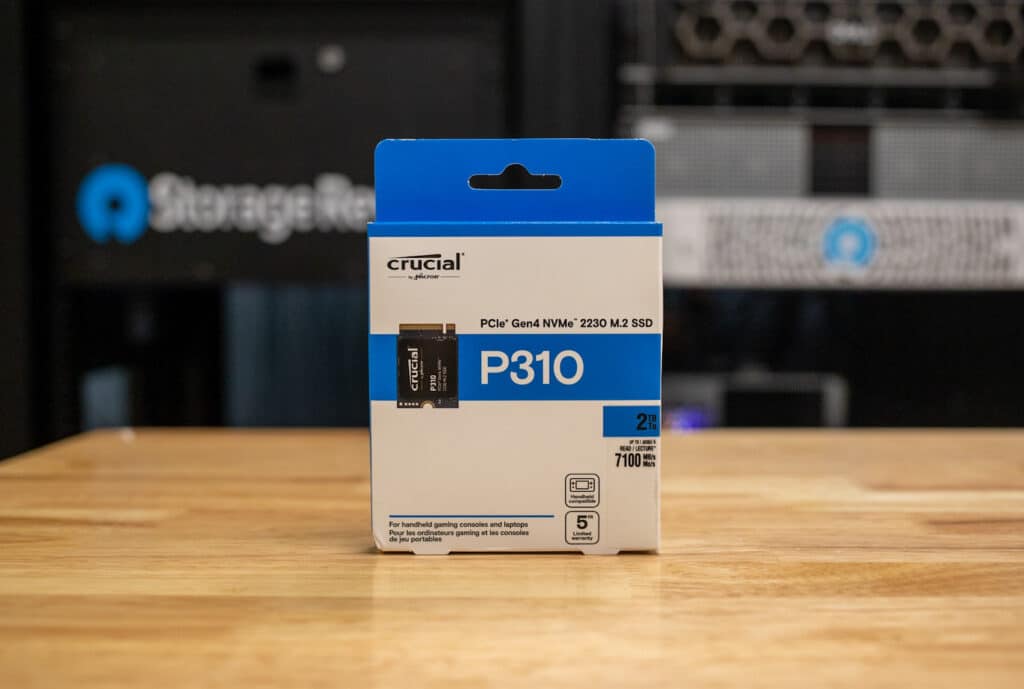
Due to its smaller form factor, the Crucial P310 is well-suited for embedded systems, IoT devices, and portable gaming consoles like the Steam Deck and ASUS ROG Ally. We haven’t seen many M.2 2230 drives in the StorageReview labs over the past several years. However, with the increasing popularity of high-performance portable gaming devices, they are being sought after more often. Regarding capacity, the Crucial P310 is available in 1TB and 2TB models, offering decent storage for gaming libraries, applications, and other data.
Crucial boldly claims it’s the fastest M.2 2230 drive on the market, making us eager to benchmark and evaluate actual performance capabilities. The P310 is powered by the Phison PS5027-E27T controller, found in other drives like the Corsair MP600 Elite and Sabrent Rocket Nano 2242, and boasts sequential read speeds of up to 7,100MB/s and sequential write speeds of up to 6,000MB/s.
It also delivers random read and write speeds of up to 1 million IOPS and 1.2 million IOPS, respectively. The endurance ratings for the P310 are also solid, with the 1TB model rated at 220TBW and the 2TB model rated at 440TBW. The mean time to failure (MTTF) is 1.5 million hours.
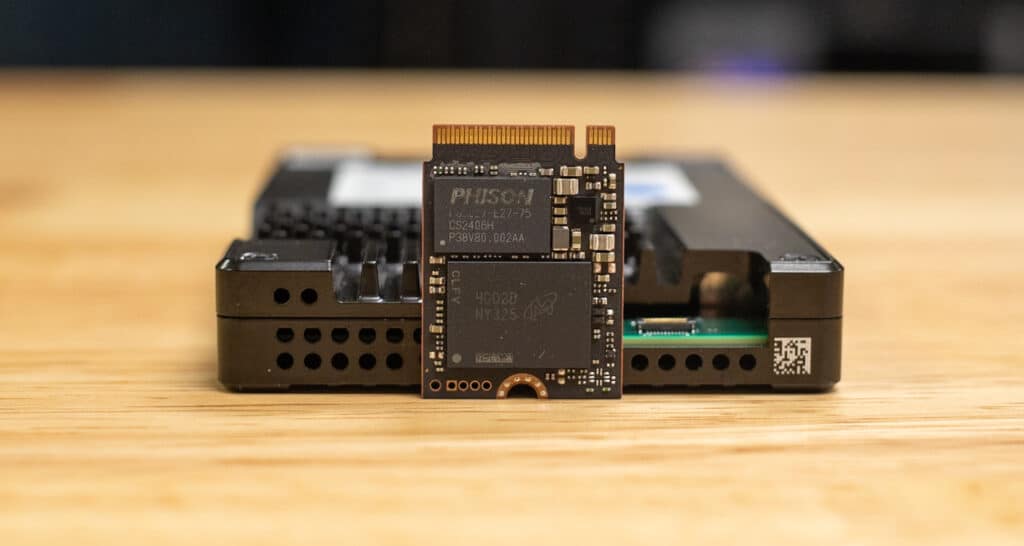
The P310 is equipped with advanced features as well to enhance performance and durability:
- Dynamic Write Acceleration: This technology improves write speeds using an adaptable pool of high-speed, single-level cell (SLC) NAND.
- Adaptive Thermal Protection: This feature manages the drive’s temperature to maintain performance and reliability by throttling the speed when necessary to prevent overheating.
- Integrated Power Loss Immunity: This ensures that data is protected during unexpected power loss, preserving data integrity by saving in-progress data to the NAND flash memory.
The Crucial P310 is also designed to be power-efficient, which is essential for extending gaming sessions on portable devices and prolonging work sessions (without frequent recharging). This balance of performance and power efficiency helps make the P310 a versatile and practical upgrade for many devices.
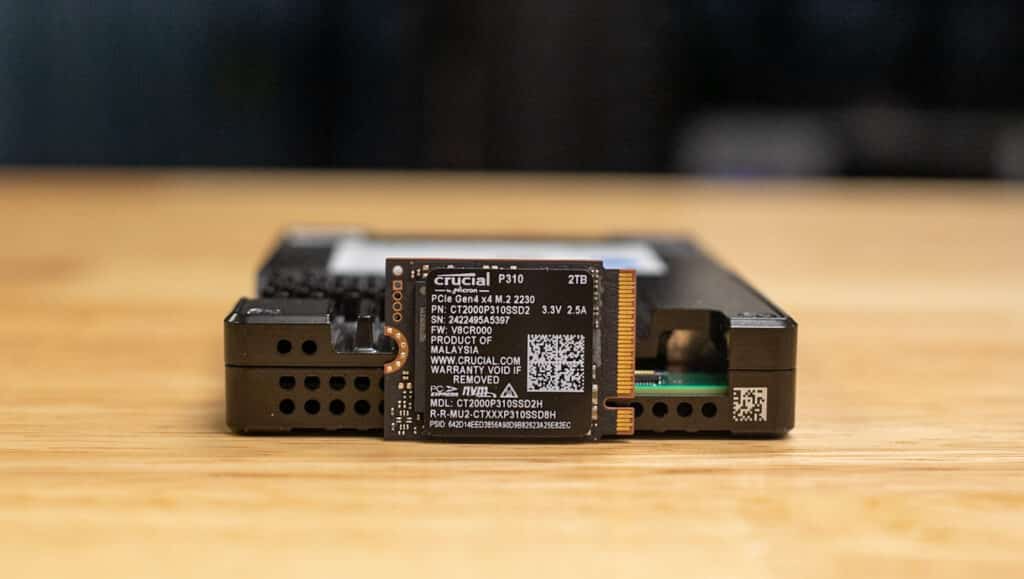
The Crucial P310, backed by a 5-year warranty, is retailed at $115 (1TB) and $214 (2TB). For this review, we will be looking at the 2TB model.
Crucial P310 Specifications
| Specification | Details |
| Form Factor | M.2 2230 |
| Interface | PCIe 4.0 NVMe |
| Capacities | 1TB, 2TB |
| Sequential Read Speed | Up to 7,100MB/s |
| Sequential Write Speed | Up to 6,000MB/s |
| Random Read Speed | Up to 1M IOPS |
| Random Write Speed | Up to 1.2M IOPS |
| Endurance (TBW) | 220TBW (1TB), 440TBW (2TB) |
| MTTF | 1.5 million hours |
| Advanced Features | Dynamic Write Acceleration, Adaptive Thermal Protection, Power Loss Immunity, TRIM Support, ECC, SMART |
| Warranty | 5-year limited warranty |
Crucial P310 Performance
Blackmagic Disk Speed Test
This benchmark is commonly used to assess the performance of storage devices in media creation environments. It tests the read and write speeds using different video formats and resolutions, making it particularly useful for users working with video editing and high-resolution media files.
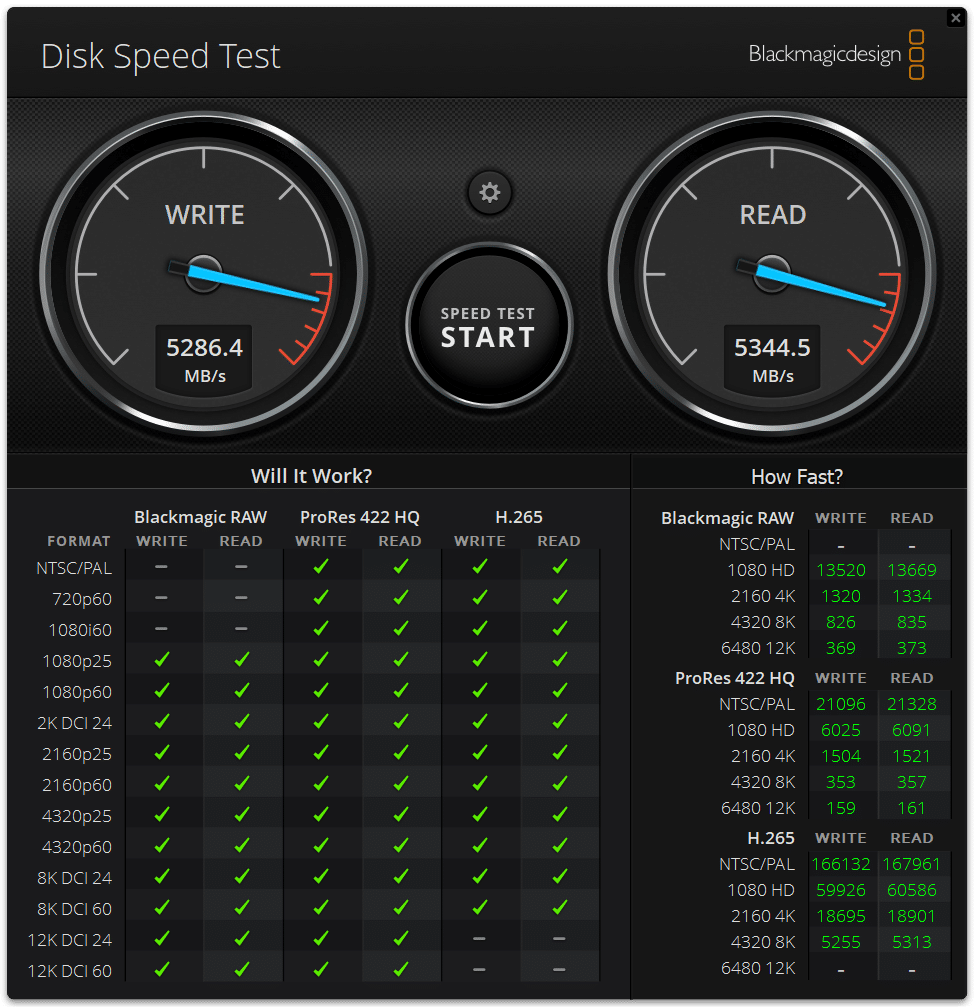
Crucial P310 2TB
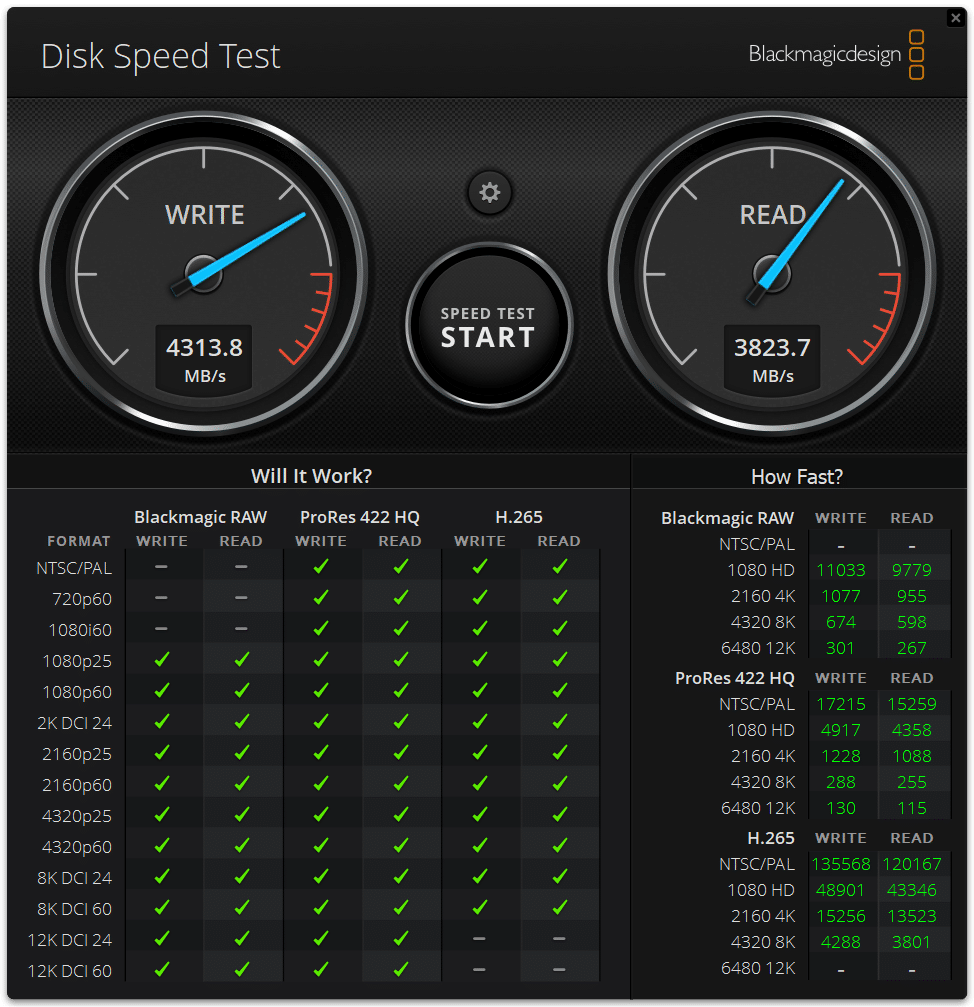
Sabrent Rocket 1TB
Here, results showcase the Crucial P310’s solid performance, with 5,286.4MB/s write and 5,344.5MB/s read. We compared it to the Sabrent Rocket 1TB 30mm (another 2230 M.2 SSD), which recorded noticeably lower write and read speeds of 4,313.8MB/s and 3823.7MB/s, respectively. While the Rocket still delivers solid performance for the small form factor, the P310 offers a big advantage for high resolutions and frame rates.
CrystalDiskMark (CDM)
CrystalDiskMark is a widely recognized tool for measuring a storage device’s sequential and random read/write speeds. It evaluates the performance using different queue depths and block sizes, providing a comprehensive view of how the drive handles various workloads, from large sequential transfers to small random operations.
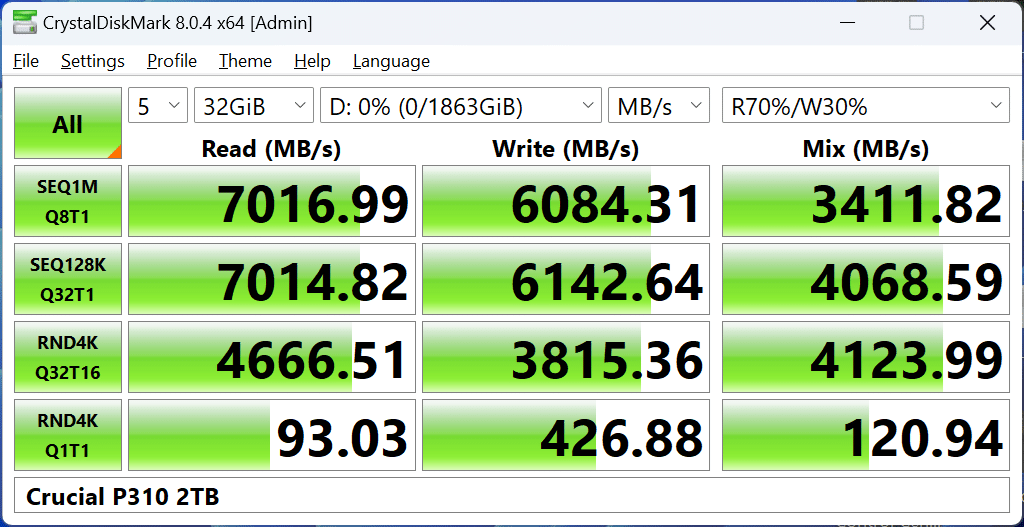
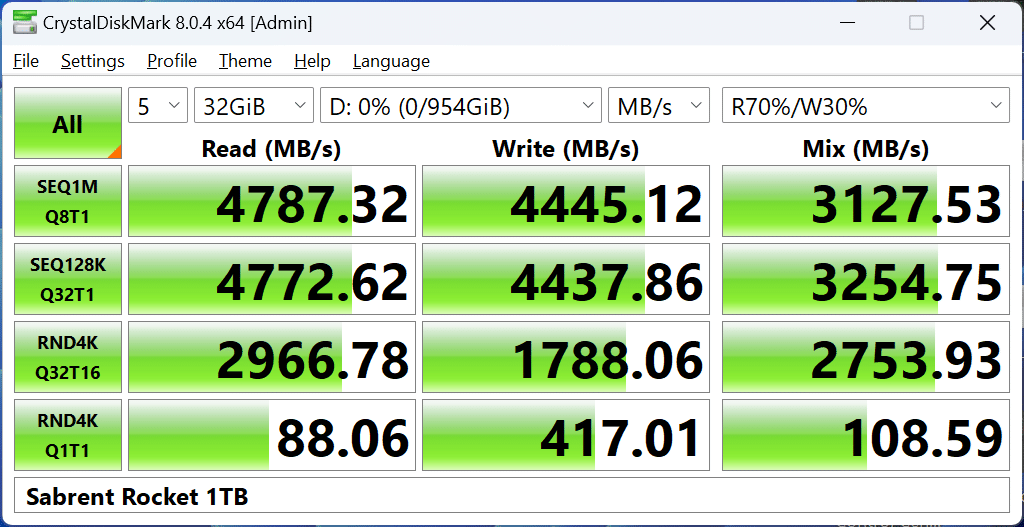 Results from this test further highlight the superior performance of the Crucial P310. It achieved sequential read speeds of 7,016.99MB/s (Q8T1) and 7,014.82MB/s (Q32T1) and write speeds of 6,084.31MB/s (Q8T1) and 6,142.64MB/s (Q32T1). These results indicate its capability to handle large file transfers and continuous data streams. Moreover, in random read and write operations at higher queue depths (Q32T16), the P310 again outperforms the Sabrent Rocket with read speeds of 4,666.51 MB/s and write speeds of 3,815.36MB/s, highlighting its efficiency in managing small, scattered files commonly encountered in everyday computing and server environments.
Results from this test further highlight the superior performance of the Crucial P310. It achieved sequential read speeds of 7,016.99MB/s (Q8T1) and 7,014.82MB/s (Q32T1) and write speeds of 6,084.31MB/s (Q8T1) and 6,142.64MB/s (Q32T1). These results indicate its capability to handle large file transfers and continuous data streams. Moreover, in random read and write operations at higher queue depths (Q32T16), the P310 again outperforms the Sabrent Rocket with read speeds of 4,666.51 MB/s and write speeds of 3,815.36MB/s, highlighting its efficiency in managing small, scattered files commonly encountered in everyday computing and server environments.
The Sabrent Rocket, while competent, lags with read speeds of 4,787.32MB/s (Q8T1) and, 4,772.62MB/s (Q32T1), and write speeds of 4,445.12MB/s (Q8T1) and 4437.86MB/s (Q32T1). For random performance, it hit 2,966.78MB/s read and 1,788.06MB/s write.
At low queue depths (Q1T1), both drives perform similarly in read and write operations.
Conclusion
The Crucial P310 M.2 2230 SSD is a high-performance storage solution for space-constrained devices, making it an excellent choice for embedded systems, IoT devices, and portable gaming consoles. With 1TB and 2TB capacities, the P310 also provides ample storage for many indie games (or a handful of AAA games) and other applications.
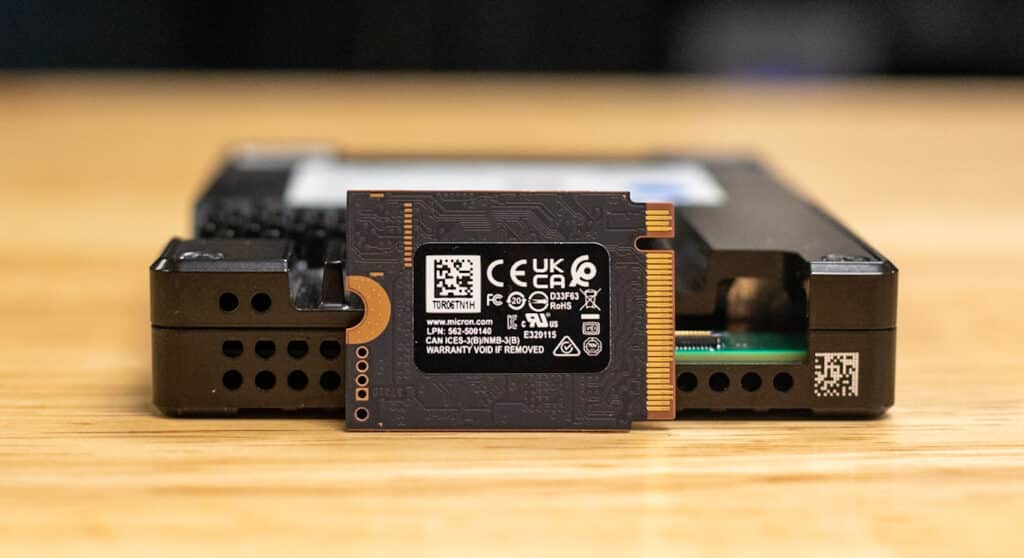
M.2 2230 drives are designed to deliver strong performance in a compact package, which is critical for maintaining these storage solutions’ sleek and portable nature. The increased demand for M.2 2230 drives (due to the popularity of devices like the Steam Deck and ASUS ROG Ally) has led to consistent advancements in their speed and efficiency, which certainly shows with the Crucial P310.
For example, the Blackmagic Disk Speed Test recorded write speeds of 5,286MB/s and read speeds of 5,345MB/s for the P310. The CrystalDiskMark benchmarks further highlighted the P310’s outstanding performance, with sequential read speeds of 7,017MB/s (Q8T1) and write speeds of 6,142.64MB/s (Q32T1). Additionally, the P310 excelled in random read and write operations at higher queue depths, demonstrating its efficiency in handling various workloads.
Overall, the Crucial P310 combines speed and capacity inside a small form factor, making it a great solution for a wide range of space-constrained devices.
Engage with StorageReview
Newsletter | YouTube | Podcast iTunes/Spotify | Instagram | Twitter | TikTok | RSS Feed

